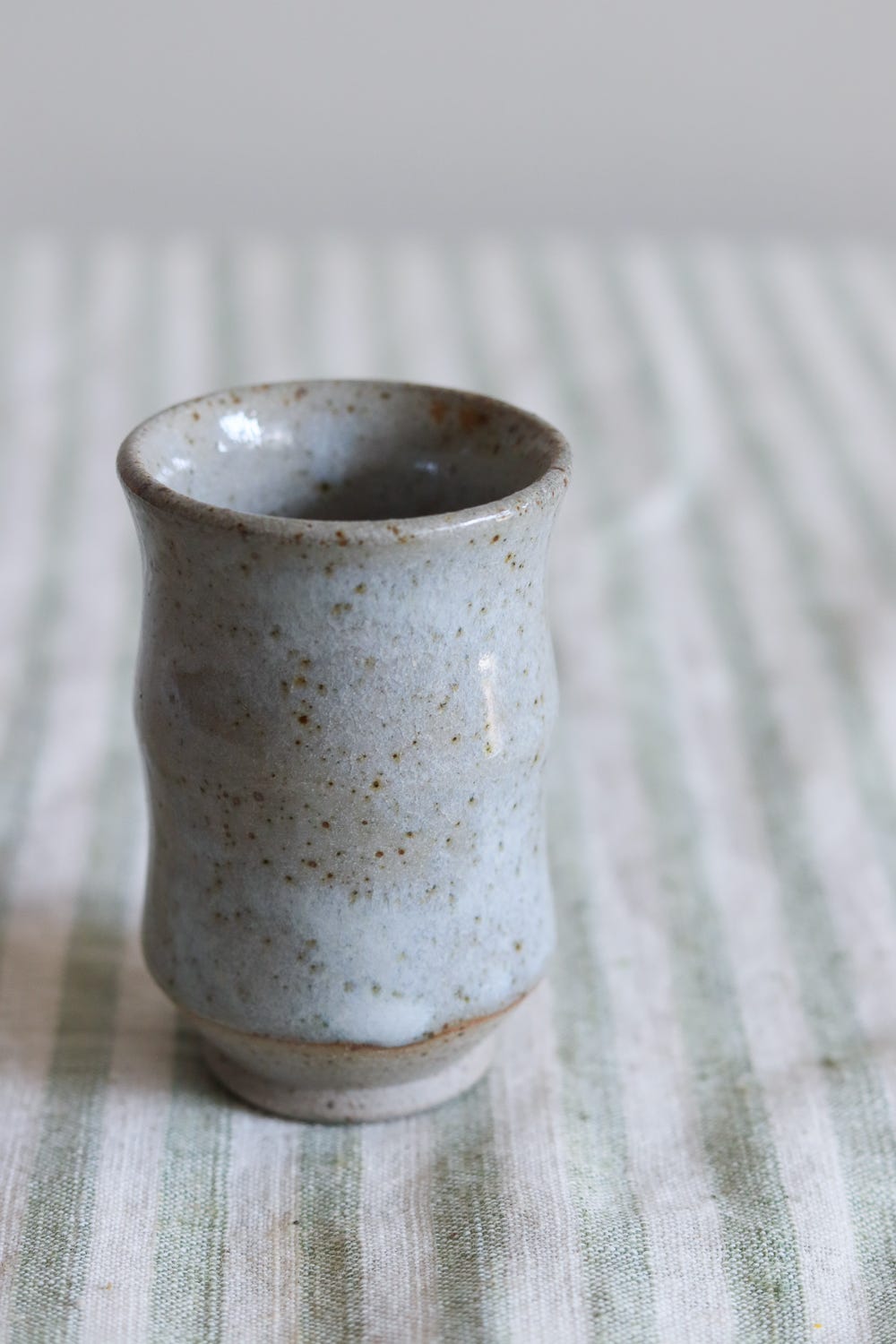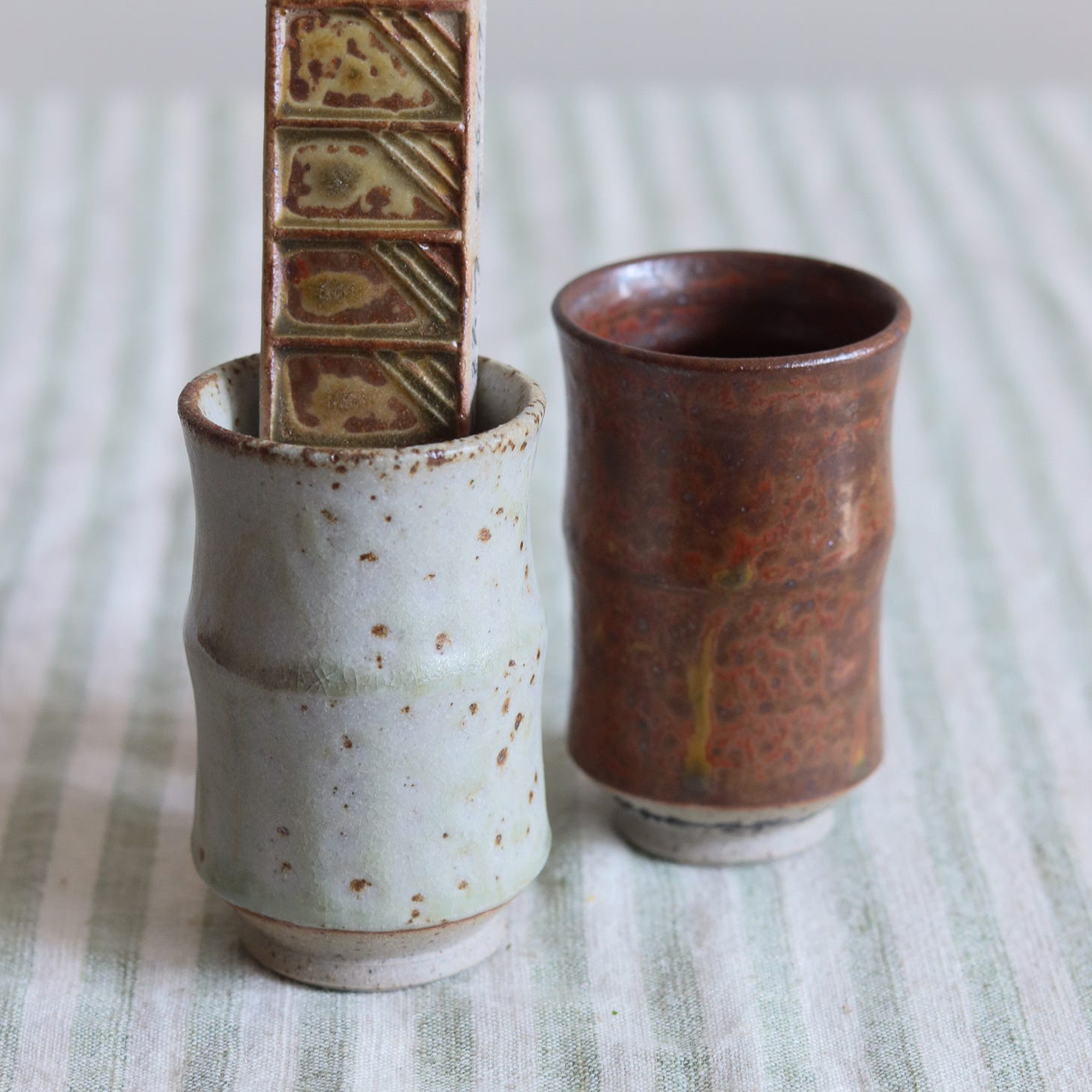Three Nukas and a Pale Ash Celadon
A deep dive into my recent round of glaze testing, plus some recipes for you to try...
Using wood ash is in glazes feels magical. Alchemical. Taking a by-product of something else (in our case, ash from our stove which kept us warm all last winter) and harnessing all the inherent minerals from within the ash to create something that is really, hopefully, quite unique. Using wood ash in glazes is a great first step into foraging for raw materials and interrogating the chemistry and geology at work in your glazes. Whilst these samples are fired in reduction, which is the more traditional way of working with wood ash, there is absolutely nothing to stop you trying them in your electric kiln - I know I certainly will be sometime soon.
I am going to share with you the results of the five glazes we tested, three nuka-type glazes, a ‘wood ash glaze’ and one ash celadon. All of these samples use stove ash, and the clay is a pale stoneware - fired to cone 11 in a reduction atmosphere - more specifically fuelled by gas.
Nuka is a traditonal Japanese glaze using the ash from rice husks and is usually a beautifully subtle milky white glaze. Because here in the UK rice isn’t really a common crop (!) we are using what we do have on hand to produce something chemically inspired by the original glaze. Purists may grumble at this, but for me it is no matter at all and I am interested more in using what I do have to hand to create something of my own rather than go down an absolute rabbit hole of authenticity.
It is important to mention that three formulas have been taken out of the Phil Roger’s book titled ‘Ash Glazes’ and have pretty much the same raw materials in differing quantities. It is so surprising to me then, how much variation we have in the final pieces. To each of these recipes I have added 2% slaked bentonite just to keep the raw materials suspended. You may notice there is very little clay within these recipes, so without the bentonite the raw materials just sink down to the bottom of the bucket and require a lot of work each time we want to use them. I won’t write about adding slaked bentonite in this piece - but I will another time. I also cover it in our book. I also include a couple of formulas I have sourced online.
Ok - let’s get started……
Test 1 - Bill Marshall Nuka, page 27, Phil Rogers Ash Glazes
Wood Ash 33.3 Potash Feldspar 40 Flint 26.6 High Fire - 1300c
Glossy, lots of iron speckles from the clay body showing through the glaze. Possibly applied too thinly - I did test the specific gravity so this is a variable for me to try again - the cloudy blue opacity occurs where the glaze is thicker. Crazing. Seems stable too.
Test 2 - Peter Swanson Nuka p173 From Phil Rogers Ash Glazes
Wood Ash 33.3 Potash Feldspar 33.3 Flint 33.3High Fire - 1300c
Although the formula for this nuka is really very similar to no. 1, it is quite different. The surface isn’t matte but it is certainly less glossy. It is milky and opaque as I thought it should be. The iron flecks in the clay softer and more yellow. Also breaks into a darker grey around the rim which is a common trait of nuka type glazes. Stable. Lightly crazed. Reminds me of icing sugar and water - I want to lick it!
Test 3 - An online recipe - (sorry I have lost the original source)
Wood Ash 33.3 Neph Sye 33.3 Flint 33.3High Fire - 1300c
A lovely ash green hue (possibly the trace iron in the raw materials and clay via the reduction process). Crazed. Glossy. Slight movement. Breaks darker round the rim as in test 2. Fascinating to me that this is almost the same formula as test 2, swapping potash feldspar for neph sye. I actually love this glaze, she’s a beauty. May not be so interesting on different forms, and possibly not so durable.
Test 4 - Marcus O'Mahony Wood Ash Glaze, p181 From Phil Rogers Ash Glazes
Wood Ash 53 Potash Feldspar 37 China Clay 10 High Fire - 1300c
On the left is the sample of the formula above - I also ran a line blend adding increments of 2% red iron oxide until I got to 8% (which is the sample on the right). The results are a matte textured glaze with that hallmark green ash pooling which is beautifully crazed. It does seem stable. I have tested in oxidation also and it is paler, the glossy ash pools more yellow than green. I’d have to think carefully about what sort of form to use this on. It will probably stain easily. I am thinking small box forms. Not sure why. The iron sample is fascinating - a sort of ‘conker’ colour and actually really beautiful.
Test 5 - Pale Ash Celadon - Online recipe with no source (we are inspired by Richard Batterham with this one)
Wood Ash 50 Potash Feldspar 35 Flint 15 High Fire - 1300c (also included a sample with 1% iron oxide and 1% cobalt oxide)
The interior of the pot is glossy whereas the exterior is more opaque with yellow tinges. Faint crazing. Lots of visual interest. Smoky. Foggy. The 1% red iron oxide sample (middle pot) is much glossier - a lovely celadon which I will 100% be exploring on a larger form. The cobalt sample just very blue - not sure what I expected! I do like it, but it is not massively interesting to me. I do like how it breaks on the line though. The cobalt sample fires similarly in oxidation so that is good to know and I might push this further in my electric kiln.
A note on the wood ash
If you know the source of your ash that is great because different species of tree give different results and it is just so interesting. We usually use ash and willow, but in these tests I am using ash from my stove and I actually don’t know what wood we have used. We have also washed our ash. I do this by soaking in plenty of water at least overnight, then sieving. This is a personal preference but I do this for a couple of reasons - firstly, unwashed ash is caustic (mixed with water it creates lye), and it hurts your skin so much! When ash is washed we are also removing soluble salts (arguably lots of interesting minerals and many potters don’t wash their ash because it can be remove some character, arguably).
One thing that I should mention here is that whilst usually I sieve my washed ash through at least an 80 mesh sieve, the ash used here, for a reason I can’t remember (probably lack of time), only went through a kitchen sieve before being dried). This caused me a bit of a headache because when I mixed up my recipes I sieved them all through 100 mesh, which took AGES. But also, I definitely did not have the amount of wood ash in my glazes that I was supposed to. Does this render my results useless? No, I don’t think so. If I want to recreate them I know how to. But I will also probably test them again with finer particles of wood ash.
All of the above is why I don’t get het up about glaze recipe secrecy. There are so many variables at play when working with raw materials, especially when so much nuance can be found in the processing of the raw materials and also the specific kiln firing schedule (we did a heavy reduction, for example).
I’d love to know your thoughts on these samples, but also if you have any subjects you’d like me to write about in future posts.










